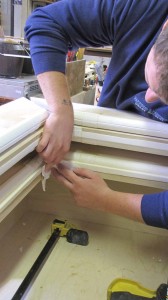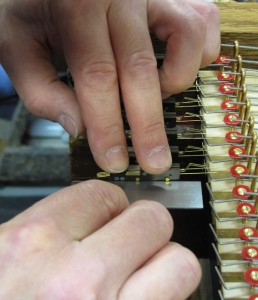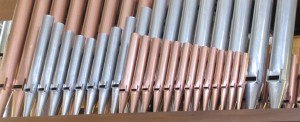ORGANS
Before 1539 there were five small organs in Durham Cathedral, and the organ “ouer the quire dore” was said to be one of the finest in England. Organs have been popular in parish churches since early Victorian times. An organ in a village church might have up to 1000 pipes; the Harrison & Harrison organ in Durham Cathedral has 5734 pipes.
 Organ building has been described as “engineering in woodâ€, requiring skill and artistry in equal measure. The organ is not only a mechanical marvel, but is first and foremost a musical instrument, and each organ is unique in sound, layout and size, depending on the acoustic, the position in the building, and what it will be used for. The specification is planned in accordance with the musical requirements; the voicer translates this into pipes a suitable size and scale, which are made in our own metalshop, and the designers develop a workable layout, with casework to compliment the buildings.
Organ building has been described as “engineering in woodâ€, requiring skill and artistry in equal measure. The organ is not only a mechanical marvel, but is first and foremost a musical instrument, and each organ is unique in sound, layout and size, depending on the acoustic, the position in the building, and what it will be used for. The specification is planned in accordance with the musical requirements; the voicer translates this into pipes a suitable size and scale, which are made in our own metalshop, and the designers develop a workable layout, with casework to compliment the buildings.
O rgan builders are skilled craftsmen, working with wood, leather, glue, low-voltage electrics and metal for pipes. Larger organs have electronic interface at the console to assist the organist in selecting stops to create different colours of sound for the liturgy or for the concert repertoire. Components are made in the workshop, using hand-tools and wood-working machines, and each organ is assembled to ensure that it is working perfectly before being dismantled and transported to its destination. Finally,the voicers create the special musical architecture which will harmonise with that particular building stand foremost a musical instrument, and each organ is unique in sound, layout and size, depending on the acoustic, the position in the building, and what it will be used for.
rgan builders are skilled craftsmen, working with wood, leather, glue, low-voltage electrics and metal for pipes. Larger organs have electronic interface at the console to assist the organist in selecting stops to create different colours of sound for the liturgy or for the concert repertoire. Components are made in the workshop, using hand-tools and wood-working machines, and each organ is assembled to ensure that it is working perfectly before being dismantled and transported to its destination. Finally,the voicers create the special musical architecture which will harmonise with that particular building stand foremost a musical instrument, and each organ is unique in sound, layout and size, depending on the acoustic, the position in the building, and what it will be used for.
Harrison & Harrison’s approach to organ building is nothing if not thorough.
 Every organ is designed individually for its specific building, to fit both the acoustics and the architecture; and great care is taken to ensure that each organ has a logical and accessible internal layout. Harrisons use Computer Aided Design (CAD), which has the advantage of ease in producing accurate, detailed working drawings, and allows our designers to experiment with a variety of layouts.
Every organ is designed individually for its specific building, to fit both the acoustics and the architecture; and great care is taken to ensure that each organ has a logical and accessible internal layout. Harrisons use Computer Aided Design (CAD), which has the advantage of ease in producing accurate, detailed working drawings, and allows our designers to experiment with a variety of layouts.
- We make our own organs in our own workshop.
- Nothing is mass-produced: not a single tracker or power-motor is made without a particular organ in mind. There are no short cuts.
- The firm has an unbroken tradition of slider chests, going back to 1861.
- We cast our own pipe metal by traditional methods to the specification required for each stop.
- The firm’s own voicers control every aspect of the organ’s musical development.
- Each new organ is first set up in our workshop to ensure that every part is functioning correctly. It is then dismantled and packed for dispatch.
- After it has been installed by our own organ builders, the instrument is finished with the detailed voicing and tonal blending for which the firm is renowned.
We provide a prompt and efficient maintenance service.
